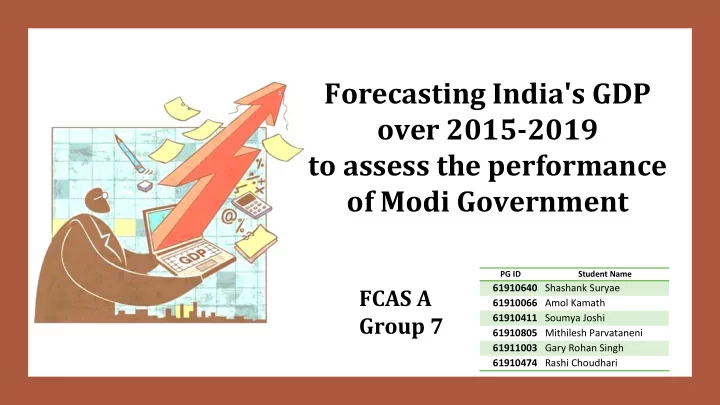

Forecasting India's GDP over 2015-2019 to assess the performance of Modi Government PG ID Student Name 61910640 Shashank Suryae FCAS A 61910066 Amol Kamath 61910411 Soumya Joshi Group 7 61910805 Mithilesh Parvataneni 61911003 Gary Rohan Singh 61910474 Rashi Choudhari
Business Problem This project is financed by the Department of Expenditure, Ministry of Finance, India with the aim of assessing the impact made by the Government of India on the GDP during the years 2014-2019 or its years in power Specifically, the impact made by the various schemes that were introduced by the Govt. of India as a panacea for the problems faced by Indian industries. Challenges that we faced while building this forecasting model : 1. Unavailability of reliable data for certain GDP components 2. Only annualized data is available resulting in small data sets for modeling 3. Discounting external global factors and their impact on the Indian GDP
Business Problem Client Goals 1. The client will use this project to compare the country’s actual GDP against the forecasted GDP 2. To pitch the incumbent party’s successful solution in improving the economical situation of the country Forecasting Impact A model that under-forecasts the GDP implies that the Government was successful in making India better as compared to the usual growth pattern and paints the Government in a favorable light while a model that over-forecasts does the exact opposite
Forecasting Goal • To accurately forecast GDP over a forecasting horizon of 5 years (2014-2019), the GDP was broken down to its base components – Household consumption, Government consumption, Gross Capital Formation, Net of Exports • Each of these components was separately evaluated and forecasted using a variety of different forecasting methods and models • These were then combined to generate the total GDP forecast • These forecasted GDP values were then compared with the actual values and the impact of the Government schemes was assessed • In addition to the above GDP components, employment was also forecasted and used to get a GDP estimate for comparison purposes
Data Description The World Bank - https://data.worldbank.org/country/india was used as the data source for this forecasting exercise. Data components – Annualized • GDP (current US$) – 1960 - 2017 • Households and NPISHs final consumption expenditure (Current US$) – 1960 - 2017 • General government final consumption expenditure (Current US$) – 1960 - 2017 • Gross capital formation (Current US$) – 1960 - 2017 • Net of Exports (Current US$) – 1960 - 2017 • Employment to population ratio – 1991 - 2017
Forecasting Methods & Outputs Direct GDP Household Governmen Net Exports Investments Employmen Forecast Expenditure t t Expenditure Regression ARIMA model Regression Exponential Holt-winters Double (Quadratic with with lag-1 (Multiplicative (optimized) (additive) Exponential seasonality) Seasonality) Year Direct GDP Household Government Net Exports Investments Employment Forecast (in Bn $) Expenditure Expenditure 2015 1285.6876 2020.8395 220.487 -60.8936 714.4857773 690003216.4 2016 1395.3661 2239.4323 238.619 -60.8936 735.300555 694336320.5 2017 1515.2553 2463.8382 257.124 -60.8936 756.1153326 698669424.5 2018 1646.3734 2518.4852 260.753 -60.8936 776.9301103 703002528.5 2019 1789.8465 2774.5451 293.107 -60.8936 797.7448879 707335632.6
Forecasting Methods & Outputs Year Direct GDP GDP from 4 UCL from 4 LCL from 4 GDP forecast from Actual GDP Figures Forecast (in Bn $) components components components Employment (World Bank) 2015 2020.8395 2159.767 2324.009 1995.525 1805.946 2102.390809 2016 2239.4323 2308.392 2472.634 2144.150 1856.053 2274.229711 2017 2463.8382 2467.601 2631.843 2303.359 1906.16 2600.818244 2018 2518.4852 2623.163 2787.405 2458.921 1956.267 2823 (P) 2019 2774.5451 2819.805 2984.047 2655.563 2006.374 3035 (P)
Data Evaluation Partitioning Metrics Benchmark Comparison • Training (1965 - 2009) • RMSE, MAPE for • Naïve model was used • For every dataset, we reviewing the errors as the benchmark for compared the metrics • Validation (2010 - 14) every time series data and chose the model • Residual plots to check if • Forecast (5 years) against which other with lowest errors & trend & seasonality was methods were appropriate residual captured compared plot
Conclusion
Conclusion • The GDP has outperformed the mean prediction in all 3 cases • It touches the 95% UCL of GDP for 4 components - Statistical errors are defined when collectively measured in the set • This implies that the government has done a good job of changing the trajectory of GDP • GDP forecasted through employment is significantly lower - indicating an increase in productivity amongst the employed workforce • This report can be used as a work of proof to showcase the achievements of the current government and by the ruling party for the upcoming elections
Recommend
More recommend